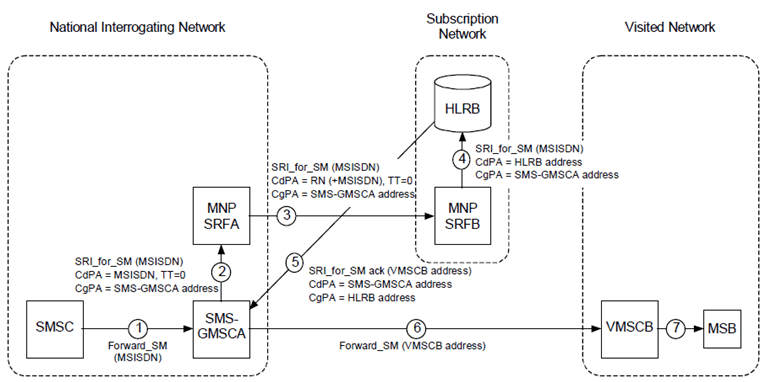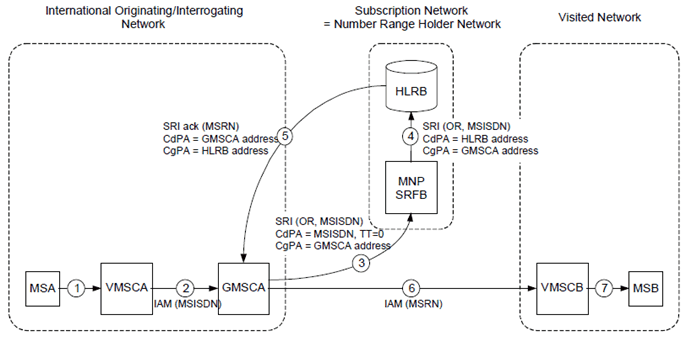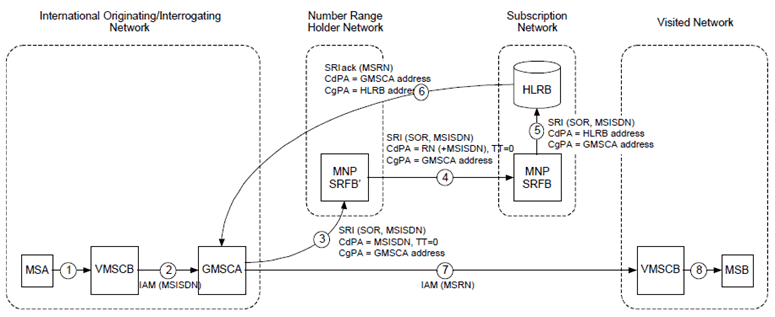Content for TS 23.066 Word version: 18.0.0
B.4.4 Delivery of SMS to a Ported Number - Direct Routeing
B.4.5 International SOR for a Non-ported Number
B.4.6 SOR for a Ported Number - Indirect Routeing
...
...
B.4.4 Delivery of SMS to a Ported Number - Direct Routeing p. 51
Figure B.4.4 shows the MNP-SRF operation for delivering an SMS message to a ported number where the interrogating network supports direct routeing.
The message flows for this scenario are based on the use of an SCCP-relay function in the MNP-SRFs. If the MNP-SRFs use a higher-level relay function (e.g. TC-relay), then the response message will go via the MNP-SRF as shown in clause B.4.2. For further details of the signalling relay functions, the reader is referred to [7].

Figure B.4.4: SRF operation for delivering an SMS message to a ported number where the interrogating network supports direct routeing
(⇒ copy of original 3GPP image)
(⇒ copy of original 3GPP image)
- The SMSC forwards a SM to the SMS-GMSC via a proprietary interface.
- The SMS-GMSC generates a routeing enquiry for SM delivery. The MAP SRI_for_SM message is routed to the network's MNP-SRF.
- When MNP-SRFA receives the message, MNP-SRF operation is triggered. The MNP-SRF functionality analyses the MSISDN in the CdPA and identifies the MSISDN as being ported using information which may be retrieved from an NP database. As the message is non-call related, the MNP-SRF function then populates the CdPA with either a routeing number or a concatenation of a routeing number and MSISDN. After modifying the CdPA, the message is routed to MNP-SRFB in the subscription network.
- When MNP-SRFB receives the message, MNP-SRF operation is triggered. The MNP-SRF functionality analyses the MSISDN in the CdPA and identifies the MSISDN as being ported into the network using information which may be retrieved from an NP database. The MNP-SRF function then populates the CdPA with an HLRB address. After modifying the CdPA, the message is routed to HLRB.
- HLRB responds to the routeing enquiry by sending back an SRI_for_SM ack with the address of the VMSC.
- The SMS-GMSC can now deliver the message to the VMSCB using a Forward_SMS message.
- VMSCB further delivers the message to MSB.
B.4.5 International SOR for a Non-ported Number p. 53
Figure B.4.5 shows the MNP-SRF operation for optimally routeing an international call to a non-ported number.
The message flows for this scenario are based on the use of an SCCP-relay function in the MNP-SRF. If the MNP-SRF uses a higher-level relay function (e.g. TC-relay), then the response message will go via the MNP-SRF as shown in clause B.4.2. For further details of the signalling relay functions, the reader is referred to [7].

Figure B.4.5: SRF operation for optimally routeing an international call to a non-ported number
(⇒ copy of original 3GPP image)
(⇒ copy of original 3GPP image)
- MSA originates a call to MSISDN.
- VMSCA routes the call to the originating network's GMSCA.
- When GMSCA receives the ISUP IAM, it requests routeing information by submitting a MAP SRI with SOR parameter set to the number range holder network of the dialled MSISDN. Within the number range holder network, the message is routed to the network's MNP-SRF.
- When MNP-SRFB receives the message, MNP-SRF operation is triggered. The MNP-SRF functionality analyses the MSISDN in the CdPA and identifies the MSISDN as being non-ported using information which may be retrieved from an NP database. The MNP-SRF function then populates the CdPA with an HLRB address. After modifying the CdPA, the message is routed to HLRB.
- When HLRB receives the SRI, it responds to the GMSCA by sending back an SRI ack with a MSRN.
- GMSCA uses the MSRN to route the call to VMSCB.
- VMSCB further establishes a traffic channel to MSB.
B.4.6 SOR for a Ported Number - Indirect Routeing p. 54
Figure B.4.6 shows the MNP-SRF operation for optimally routeing a call (using SOR) to a ported number where the interrogating network does not support direct routeing.
The message flows for this scenario are based on the use of an SCCP-relay function in the MNP-SRFs. If the MNP-SRFs use a higher-level relay function (e.g. TC-relay), then the response message will go via the MNP-SRF as shown in clauseB.4.2. For further details of the signalling relay functions, the reader is referred to [7].

Figure B.4.6: MNP-SRF operation for optimally routeing a call (using SOR) to a ported number where the interrogating network does not support direct routeing
(⇒ copy of original 3GPP image)
(⇒ copy of original 3GPP image)
- MSA originates a call to MSISDN.
- VMSCA routes the call to the network's GMSCA.
- When GMSCA receives the ISUP IAM, it requests routeing information by submitting a MAP SRI with SOR parameter set to the number range holder network of the dialled MSISDN. Within the number range holder network, the message is routed to the network's MNP-SRF.
- When MNP-SRFB' receives the message, MNP-SRF operation is triggered. The MNP-SRF functionality analyses the MSISDN in the CdPA and identifies the MSISDN as being ported using information which may be retrieved from an NP database. As the message is non-call related, the MNP-SRF function then populates the CdPA with either a routeing number or a concatenation of a routeing number and MSISDN. After modifying the CdPA, the message is routed to MNP-SRFB in the subscription network.
- When MNP-SRFB receives the message, MNP-SRF operation is triggered. The MNP-SRF functionality analyses the MSISDN in the CdPA and identifies the MSISDN as being ported into the network using information which may be retrieved from an NP database. The MNP-SRF function then populates the CdPA with an HLRB address. After modifying the CdPA, the message is routed to HLRB.
- When HLRB receives the SRI, it responds to the GMSCA by sending back an SRI ack with a MSRN.
- GMSCA uses the MSRN to route the call to VMSCB.
- VMSCB further establishes a traffic channel to MSB.